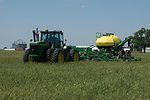Items Tagged with 'herbicides and cover crops'
ARTICLES
No-Till Farmer Web Page Offers Tips on Managing Prevented Planting Acres, Disaster Aid
The editors of No-Till Farmer, Strip-Till Farmer and Cover Crop Strategies assembled this web page to serve as a source for growers looking for options on prevented-planting acres in the U.S. and potentially find sources of disaster aid.
Read More
[Podcast] What You Need to Know About Herbicides and Planting Covers
Herbicides can be tricky to work around when cover crops are included in the rotation. So, how can you ensure you're maximizing the effectiveness of cover crops when herbicides are involved in your farming system?
Read More
[Podcast] Tips for Interseeding Cover Crops Into Knee-High Corn
Every grower wants to know how to make cover crops pay off on their farm but there can be myriad challenges, including climate. One approach is interseeding covers into standing corn to increase the amount of growing time and benefits rendered by covers to farm operations.
Read More






